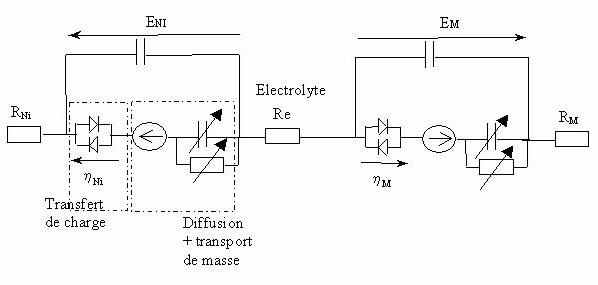2.
Modeling of electrochemical devices adapted to the Electric Engineering.
The
critical point of the systems with embedded energy remains the storage
system. In the major part of the current applications, storage is carried
out in an electrochemical way; nevertheless, the operation and the modeling
of these devices are badly known in the Electric Research community.

Model
of NiMh battery.
Studies,
primarily directed towards the determination of the accumulators state
of load (gauges), were undertaken at the time of the various development
of the electric vehicles. Nevertheless, very few of them related to
a more general operation (for example, the dynamic behavior), because
of the complexity of the phenomena involved and the "double scientific
competence" necessary to their understanding.
In
parallel, the multiplication of the "applications to portable energy",
or even the increasingly significant electric outputs, necessary on
board of the traditional vehicles, made this kind of approach necessary.
Starting
from this statement and profiting from a favorable scientific regional
environment, the LEC and the LRCS
(Laboratory of Reactivity and Chemistry of the Solids: UPRES 6007 of
AMIENS) decided to link their efforts, to bring a certain number of
answers to this delicate problem.
The
adopted approach consists in using a standard diagram "lumped constants",
modelling well identified electrochemical phenomena. This approach allows,
at the same time, to find an agreement area between "electricians" and
"chemists" and will make it possible to use the traditional identification
approaches used in Electric Engineering.
This
action is outstanding, within the framework of a regional research Program
(Pôle
DIVA).
A
significant financial effort, so much on behalf of the Region than of
the Laboratories involved, made it possible to develop a significant,
fundamental experimental approach for this kind of subject.
In this state of mind, the LEC integrated new GDR
ME2MS and the Multidisciplinary Network Set of themes
"Energy", as of their creation on these problems.
|







